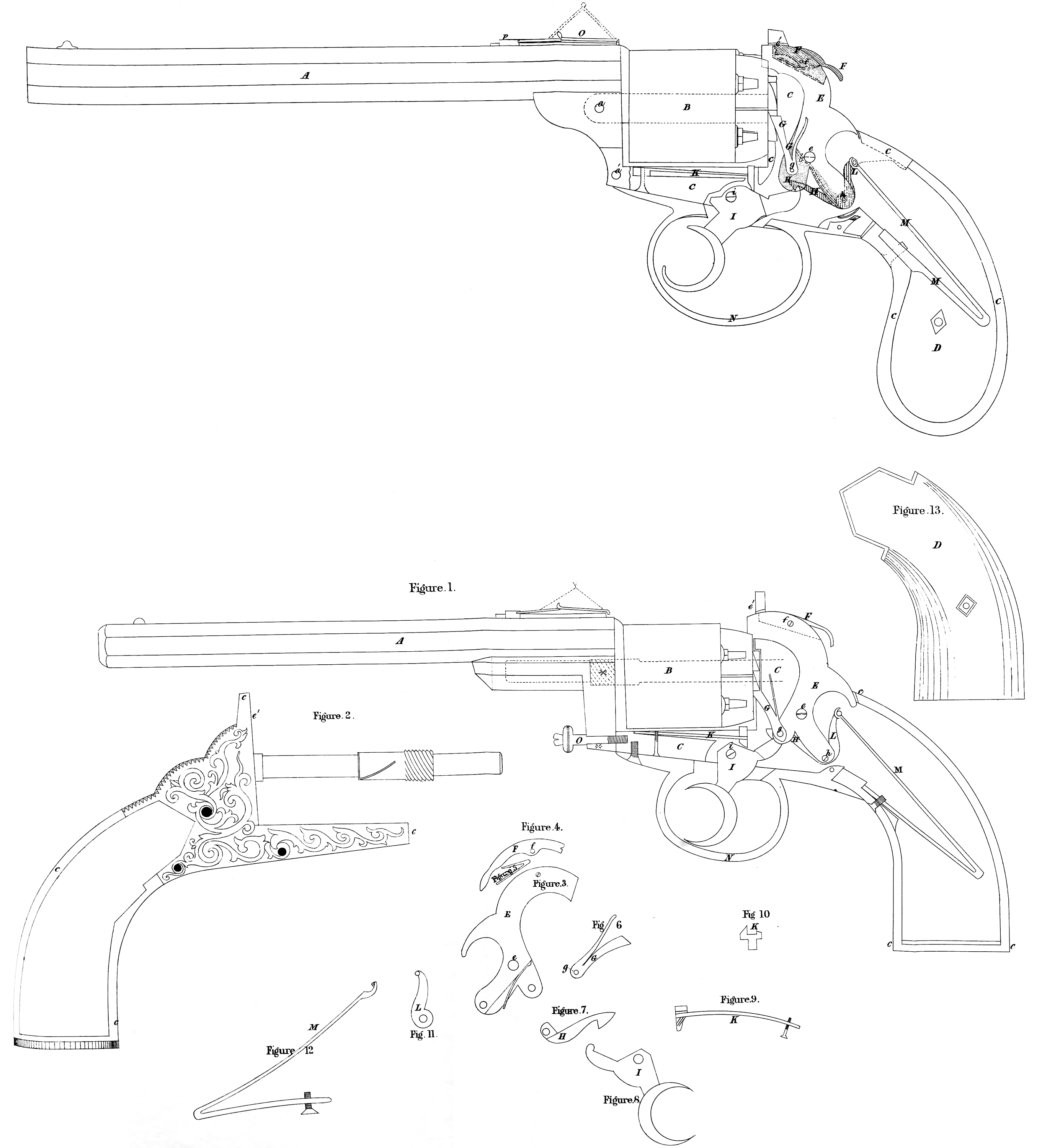British 960
LETTERS PATENT to Joseph Bentley, of Liverpool, in the County of Lancaster, Gun and Pistol Manufacturer, for the Invention of “ Impbovements applicable to Fibe-aems.”
Sealed the 3rd June 1853, and dated the 4th December 1852.
PROVISIONAL SPECIFICATION left by the said Joseph Bentley at the Office of the Commissioners of Patents, with his Petition, on the 4th December 1852.
I, Joseph Bentley, of Liverpool, in the County of Lancaster, Gun and Pistol Manufacturer, do hereby declare the nature of the said Invention for u Improvements applicable to Fire-arms ” to be as follows :—
Improvements applicable chiefly to that class of “fire arms” known as “ revolvers,” and which consists mainly in an improved bolt or catch to hold back the cock (or hammer) off the nipples during the act of loading, and the arrangements for lifting the hammer and causing the chambers to revolve during the rising of the cock, and securely holding them (the revolving chambers) in the required position during the time of firing, and an improved elevating sight. The Invention is shown in the annexed Drawing, which is a side view of a pistol upon this plan, with the side plate (coloured brown) and a portion of the metal (coloured yellow) of the stock removed to expose the lock to view. A, the barril of the pistole, B, the revolving chambers provided with nipples, between which there are safety partitions. C (coloured yellow), the metal portion of the stock which is proposed shall be formed of one piece. D (coloured brown), the side plates for the stock, and which are proposed to be made of gutta percha or papier mache. E, the hammer or cock, working upon its axis e, and through a mortise hole at e1 (in the upper part of the stock frame). Upon the top of the hammer there is a slot cut formed as shown, in which is placed F (coloured red), the bolt or lever, which works upon the pin f, and which is kept down, when not in use, by the small Y spring shown underneath it. The lever or catch serves to hold back the hammer, which is done by causing the point of the hammer to be drawn out of the mortise, when the thumb being placed on the top of the end of the lever nearest to the stock by a slight pressure, the reverse end is raised out of its position, when the hammer, being allowed to go down again, the front end of the catch or lever comes against the stock frame just above the mortise hole, and prevents the end of the hammer passing forward; but the moment the hammer is drawn back, the catch recede into it’s groove again, so that the end of the hammer is free to pass through the mortise hole against the nipples. G, the lever for causing the chambers to revolve, and which is provided with a spring at the back to keep it against the notches or rack formed on the back of the chambers, and is attached to the hammer by the pin <7, and works in a slot formed within the stock at the side of the cock, the spring work**, ing against the back or further side thereof. H, the “ dog” (or piece of metal for hooking on to the top of the trigger), working upon the pin h, and which communicates the action from the trigger. The lower end of the cock is reduced in thickness on the reverse side (as noted on the Drawing by the red stipple), so as to allow the “ dog ” and its spring, which is shown above it in red, to work more conveniently. I, the trigger, working upon its pin i. K, the trigger spring, the working end being formed with two arms (somewhat like the letter T laid horizontally), the upper limb being notched to fit the edge of the divisions between the nipples; the lower one working against the trigger, upon being forced upwards by the action of the trigger, securely holds the chambers in their position during the time of fireing, the edge of the then lowest division being held in the notch until the return of the trigger. L, the swivel (or piece of metal) by which action is communicated to & from M, the main spring. N, the trigger guard. The dotted lines running through the chambers denote the axle upon which they revolve. The barril A, is secured by the pin

